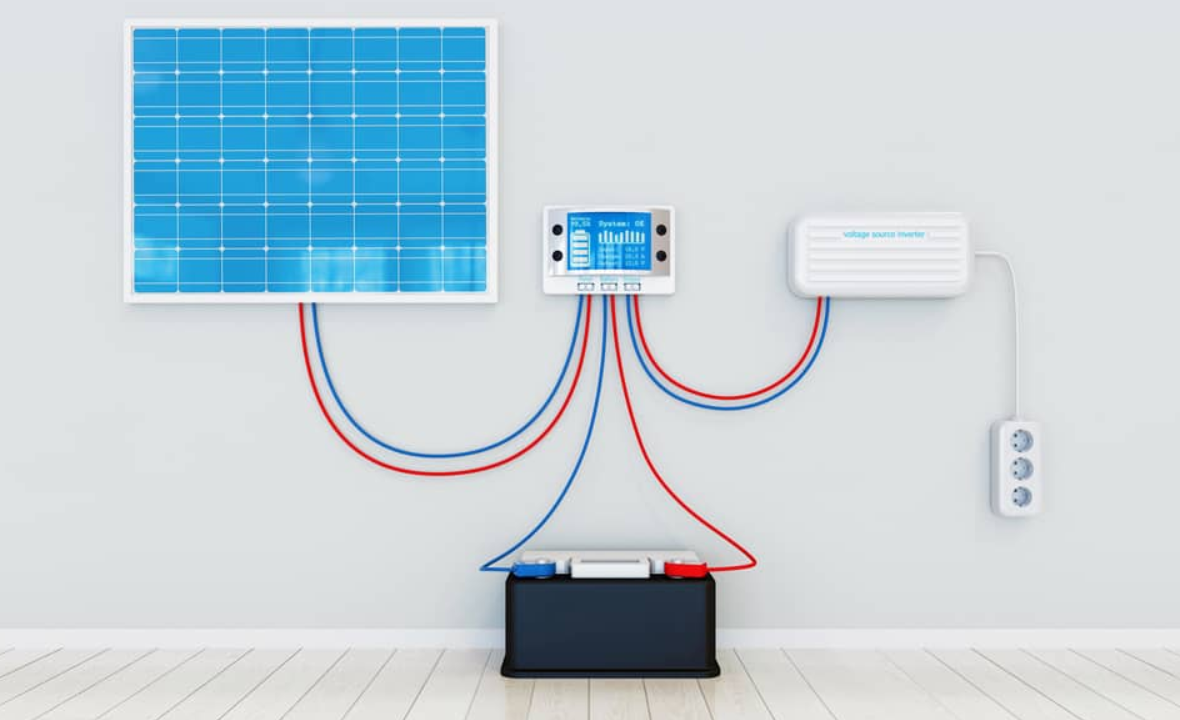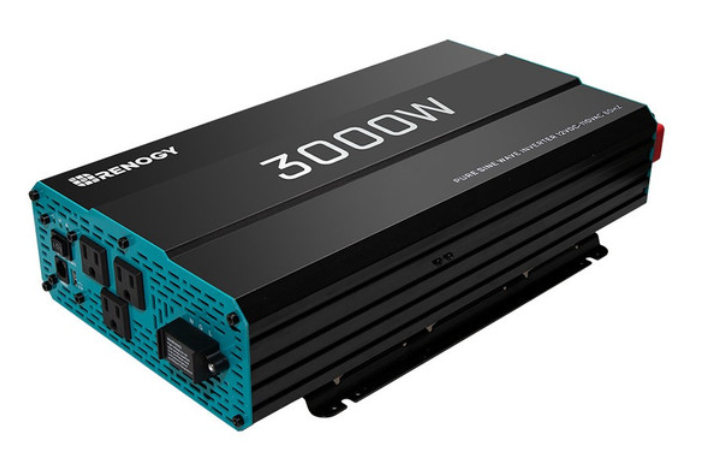For a long time, interested parties asked themselves: “Is a solar system worth it?” They know that a solar system is the easiest way to generate environmentally friendly and inexpensive electricity.
More and more people are therefore relying on electrical energy from their roofs. It doesn’t even need to be much to use solar power.

The inverter of the solar system takes on a particularly important task. In our article, we will explain to you how this works and how the power of the inverter should be designed compared to the power of the solar system.
What is an inverter? A PV system consists of many components coordinated with each other. This includes the solar modules, the PV generator, the inverter, and, if necessary, a power storage unit or a wall box.
The solar panels installed on the roof of your home or garage use the sun’s incoming rays to convert them into energy and thus generate direct current (DC). However, electricity cannot be used in the household at this point because The public grid and thus your household run on alternating current (AC).
Your solar system needs an inverter pure sine wave to convert the direct current into an alternating current. This electricity can then be used directly in the household, stored in the electricity storage system, or fed into the public electricity grid.
Modern inverters can also take on many other tasks in connection with an energy meter. We briefly summarize some of them for you:
- Achieving maximum returns
- The monitoring and control of the entire PV system
- The collection of operational data
- Interruption of the grid feed
- Protection of the network against overload
What Do Kw and Kwh Mean?
To ensure smooth conversion of electricity, the performance of the solar modules must be matched to the performance of the inverter. But at this point, many people interested in PV are understandably unsettled.
Because the power of the inverters is given in kW, the power of the solar systems is given in kWp. Therefore, some of our customers ask themselves: What does the p in kWp stand for? The answer is very simple:
The designation kWp stands for kilowatt peak, whereby peak in German means peak or summit. This is the peak performance of the solar panels system under standard test conditions (STC). Particularly important here: Such standard test conditions usually only exist in the laboratory.
Under real conditions, however, they only occur very rarely. A solar system with an output of 10 kW can generate 10 kilowatts (kW) of solar power under standard test conditions, but the actual operating conditions deviate from this.
The performance is correspondingly lower. However, the information is quite helpful. You should therefore see it more as a guideline for the solar system’s performance.
The Performance of a Solar System
But why do the real values sometimes deviate significantly from the standard test conditions and the specified output in kW? The STCs are used to compare and evaluate various solar modules independently.
For this purpose, the solar modules are tested under optimal operating conditions in the laboratory. Not only the radiation but also the temperature, the spectrum of the sunlight, and the astronomical air mass are considered.
In reality, however, the conditions usually deviate from these conditions to varying degrees. After all, the solar radiation, but also temperature, possible shading, and the orientation of the roof have an influence on the performance of the solar system during operation.
This means that the maximum PV power is rarely reached. Nevertheless, the actual yields should generally come as close as possible to the specified kWp output.
The Power of the Inverter
The real operating conditions of the solar system sometimes significantly affect the output power of the PV generator. As a result, it rarely, if ever, achieves its full-rated output.
Consider this when planning your solar system to adapt the inverter to the usual peak output of the solar system. This is the only way to improve the AC output capacity of the solar inverter.
There are a few things to consider: The inverter must first have a certain minimum voltage. The orientation of the system, as well as the shading of the solar modules, also plays a role. Below we briefly address each of these points:
1. The Minimum Voltage of an Inverter
Every inverter requires a certain minimum voltage. Because it only starts to work when a certain voltage has been reached. As a rule, the smaller the inverter, the lower the start-up voltage. This means that the inverter starts up faster and more often despite less solar radiation or other influences, generating more alternating currents faster.
2. East-West Orientation and Shading
If your roof has an east-west orientation, the real conditions deviate particularly strongly from the standard test conditions. The value of the electricity generated by your photovoltaic system is, therefore, even further removed from the kWp nominal output of the solar system. Because the solar modules only achieve half of the possible output in the morning (east) and the evening (west). In this case, a significantly smaller inverter can increase the energy yield of your solar system and compensate for the prevailing conditions.
3. Lower Investment Costs
However, installing a smaller inverter has another advantage: the smaller the inverter, the cheaper it becomes. The three-phase inverters in large systems only differ slightly in price – there is often only a 100 euro difference between the largest and second-largest model. But especially with smaller systems between 4 and 5.5 kWp, you can use the single-phase inverter instead of the three-phase one without hesitation, which is around 300 euros cheaper.
But: It is fundamental to say that the partial load behavior of inverters has improved significantly in recent years. As a result, large or too large inverters can still show good efficiencies even with lower generation power.
Find the Right Inverter
A large selection of inverters makes it difficult to make a decision. We summarize some tips that can help you to choose the right inverter:
In any case, consult a specialist company that will advise you on selecting your components and, thus, your inverter. Because these should always be well coordinated and ideally sold and installed as a complete package by the specialist company of your choice.
Always have several offers made for you before you buy your solar system. This way, you can compare the offers and selection of inverters from different specialist companies.
If you have already received several offers, you can find out more about the selected inverters and their advantages and disadvantages and find out which suits your requirements better.
As explained above, when selecting the right inverter, the orientation of the solar system should always be taken into account in addition to the output because this factor in particular decides on the choice of the right inverter power.
Design of PV Inverters
In addition to selecting the right inverter, there is usually a design question in the room. In the best case, the specialist company you have commissioned will advise you on this step.
This is because they can access special design software. All well-known manufacturers provide these programs free of charge for this purpose. This makes it easy to determine the optimal design for your inverter from SMA, Kostal, and many other manufacturers.
Of course, the design of PV inverters can also be calculated without special software. In addition to the performance of the solar modules, the following factors must be taken into account at this point:
- AC/DC-rated power
- Voltage range
- Temperature
However, we advise against calculating the design for your solar system yourself. Usually, these calculations only result in estimated values and should only serve as a guide.
So always have a professional calculate the design for your PV system because he knows which factors have to be taken into account and how your PV system, including the inverter, will later work most profitably.
How Many Inverters Does the Photovoltaic System Need?
As with all PV system components, this question cannot be answered universally. The number of inverters suitable for a PV project depends on many factors – in particular, the size and area of application of the solar system – and should, therefore, always be considered individually.
In general, however, one inverter is usually sufficient for average solar systems in the private sector. Because this inverter can also be selected so that shading is not a problem and you get the most out of your off grid solar system. In addition, you can save both costs and space in this case.
So get sufficient information from experts in advance regarding the number of inverters. They can advise you individually and find the right solution for your project.
How Much Do Inverters Cost?
The exact costs for an inverter cannot be specified as a flat rate either. These always depend entirely on the selected model and manufacturer. The device’s price is also influenced by factors such as the nominal power or the scope of services.
To be able to give you an approximate estimate of the costs of an inverter, we present two simple guide values that you can use as a guide:
The costs for an inverter usually make up around 15 percent of the total costs of a PV system. You can calculate around 400 euros (gross, including installation) per kilowatt of installed inverter power for your inverter.
However, it would help if you kept in mind that the market situation is currently very dynamic, and prices vary greatly.
Conclusion
Contrary to what many people interested in PV think, inverters do not necessarily have to be designed as large as the kWp output of the solar system suggests. Instead, it makes sense to choose a smaller inverter to maximize the yield.
However, large inverters are often suitable for south-facing solar systems with dynamic feed-in. On the other hand, smaller inverters are particularly suitable for systems with an east-west orientation, shading, or static feed-in control.











